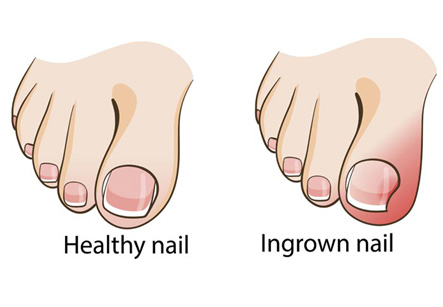Ingrown Toenails
Introduction
An ingrowing toe nail is a common condition causing discomfort or become infected. It commonly occurs in immune-compromised individuals, diabetic patients, and trauma or even by faulty nail cutting techniques. Various treatments have been developed by doctors or podiatrist (chiropodist) to treat this condition.
The nail ingrowing usually occurs when the side of the nail grows into the skin next to the nail. This new site of the nail can become painful. The skin near the nail can also become infected or inflamed. The big toe is commonly affected; although any toe can be involved. It is a common problem, especially of teenagers and young adults.
Causes
There is no apparent reason for ingrowing nails. Some of the common causes postulated are tight or ill-fitting shoes, very short and round cutting of nails instead of cutting them straight across. Straight cutting of nails usually prevents ingrowing toe nails from developing. In some cases, injury to nails, fungal infection or some medications like isotretinoin are said to be responsible.
We have all the information you need about public and private clinics and hospitals that provide Podiatry-Chiropody treatments in Iran, Islamic Republic Of with the best quality and lowest possible prices

Treatment for an ingrowing toe nail
Skin specialist or podiatrist generally treats the ingrowth of nails. In rare cases, surgical intervention is necessary.
Treatment in early cases
The principle of this treatment is to avoid the skin from growing over the edge of the nail.
1. Small ingrowth of nails can be treated at home or by a podiatrist.
2. The affected toe is soaked in water for about 10 to 15 minutes to soften the nail folds.
3. The doctor advises to use a cotton wool bud to push the skin fold over the ingrowth downwards and away from the nail. This process is repeated daily foe at least couple of weeks to allow the nail to grow.
4. A small wisp of cotton wool is placed under the end of the nail as it grows. It helps to grow the nail over the skin. Cotton wool should be changed daily.
5. Allow the nail to grow forward until it clears the end of the toe.
6. Then, the nail is cut straight across and not in a round manner.
Infection of ingrowing nail-fold
Symptoms of infection are:
1. Pain goes on increasing
2. Swelling of nail-fold
3. Redness near the ingrowing nail
4. Pus (yellow or green fluid) forming near the nail or beneath the skin.
5. In severe cases, pulsating type of pain, redness spreading over the toe.
6. Fever in severe cases.
Antibiotics are needed to treat infection. Soaking of feet in lukewarm salty water is recommended followed by carefully drying and resting the feet.
Definitive treatment becomes necessary in following cases:
1. In case of persistent and severe symptoms
2. Infected toe nails
3. Patient on immunosuppressant medications like transplant recipients, diabetics in whom infection needs to be treated early.
4. Patients having neuropathy in feet such as diabetic neuropathy. The patient may be unaware of deep infection or an injury. Such patients need careful assessment and early treatment.
Persistent ingrowing toe nails
In such cases, a part of nail must be removed. The usual procedure for this is as follows:
1. Local anesthetic medicine is injected into the base of the toe to make it numb.
2. Then, the surgeon cuts the nail by scissors a few millimeters away from the edge having the ingrowth.
3. Then, the offending edge is pulled out.
4. To prevent the edge of the nail from ingrowing again, a small quantity of acid known as phenol is applied on the exposed nail bed.
5. Nail dressing is applied.
6. Mild pain relievers are prescribed to control the pain.
Prevention of ingrowing toe nails
1. Feet should be kept clean and dry. Fresh air is needed for toes to prevent ingrowth of nails.
2. Use of cotton socks and proper fitting shoes is recommended.
3. Cutting the corner of nails too short should be avoided. Preferably cut the nails after bath because they are soft at that time.